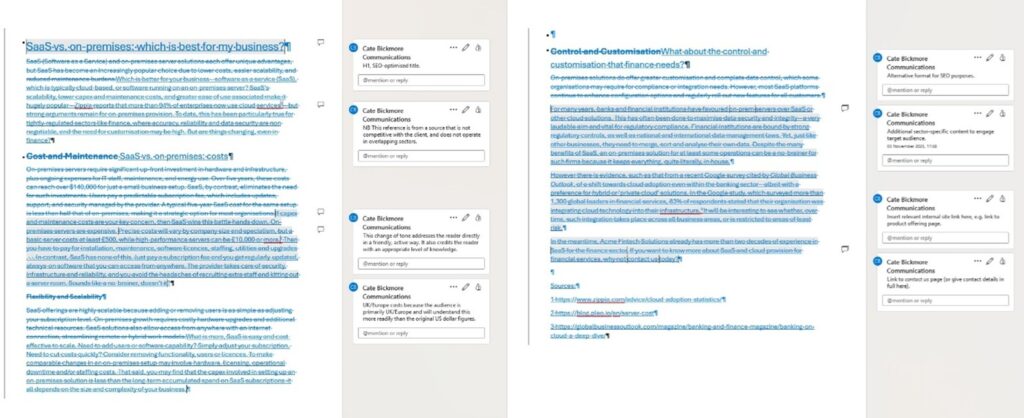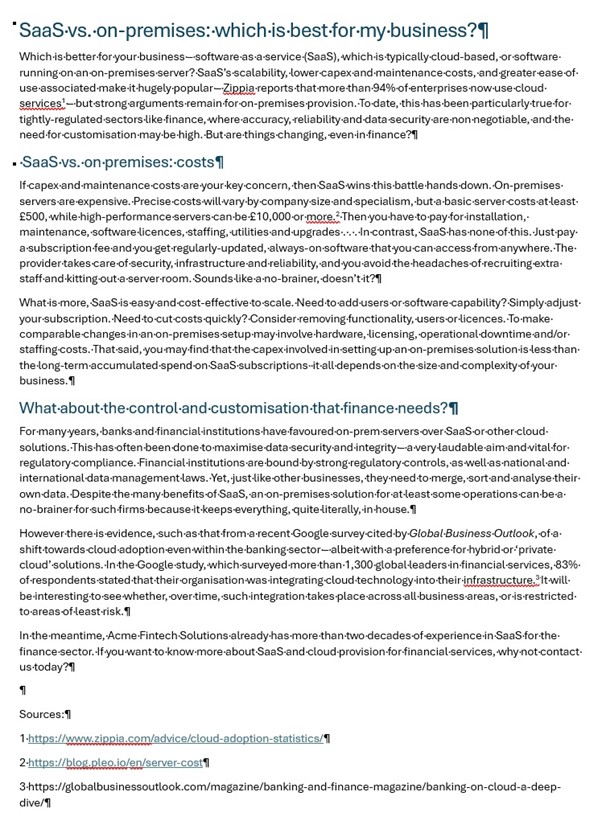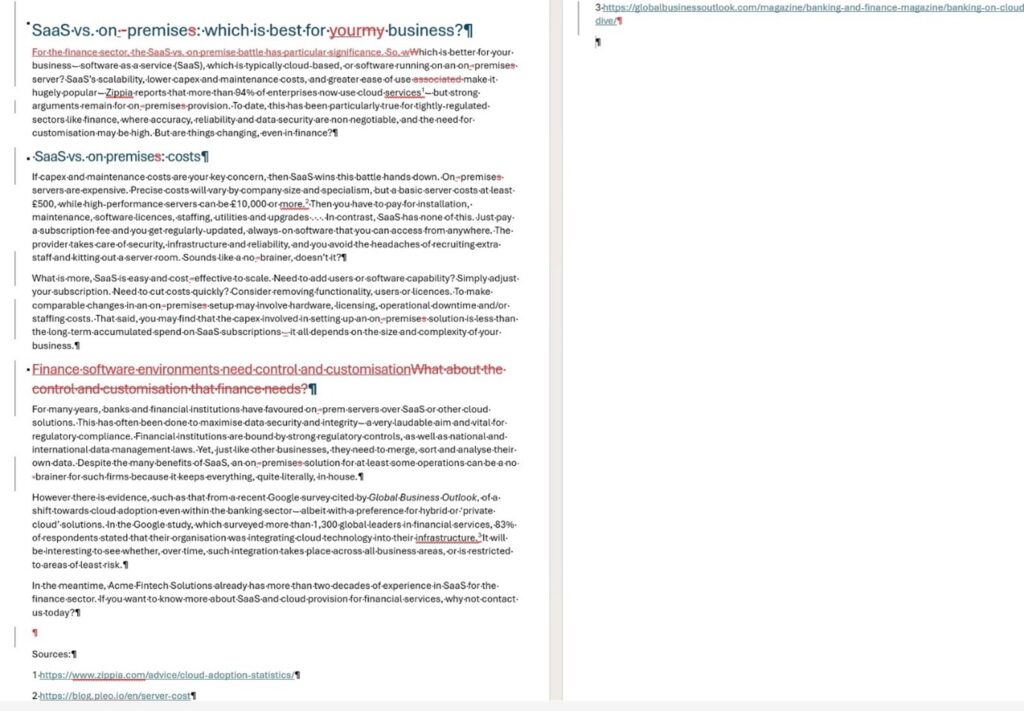How I edit AI slop into effective copy

A deeply unrealistic AI-generated image of a woman who clearly likes to edit AI slop that little bit too much. I’m not sure if that’s a grin or gritted teeth but by the time we reached this point I had used so many prompts, I gave up (sorry!)
I like to edit AI slop; it increasingly feels like a public service. As The Conversation recently reported, AI slop is everywhere. The use of unedited AI-generated copy is now so common, it’s reducing the internet to mush. Consequently, using raw AI copy is now a great way to camouflage your business so that it vanishes into that mush. If you want to be overlooked because you sound just like everyone else, LLMs make it easy.
And yet . . . AI in general and LLMs in particular offer certain benefits. Want to scope out the current knowledge or opinion around a topic? AI lets you do that quickly and from the comfort of your desk. Information gathering that previously took several hours now takes thirty minutes. You have to check the LLM’s sources, of course. But if you’re writing or researching something uncontentious the time savings are there.
However, research is one thing; generating your copy via an AI chatbot is a whole different matter. Publishing AI-generated copy wholesale under your own or brand name is frankly dangerous. I have explained the dangers here, and I outline the solutions here, in detail. But as a quick summary, the use of unedited AI slop puts you at risk of:
- Breach of intellectual property law or regulations (This article from Technology is a good primer and this blog post by Pinsent Masons provides a useful overview of the recent Getty Images vs. Stability AI case in the UK courts, with implications. )
- Damage to, or loss of, brand value and reputation (with all the downstream losses that accompany that)
- Publication of false or misleading claims/information (and this risk is increasing, as this Cloudflare article on data poisoning explains)
- Failure to achieve benchmarking or KPI targets
So what is the solution? Let me explain.
How I edit AI slop into brand assets
‘The innovative and customisable approach used by Cate Bickmore Communications to humanise AI text and transform it into original, engaging and effective copy’ would be quite a long header, so let’s just call it The Bickmore Approach, shall we ? 😊 The Bickmore Approach takes AI slop – often chatbot-generated blog posts and articles, but all formats are considered – and transforms it in light of four key objectives:
- Minimise the risk of plagiarism and copyright breach
- Customise the tone to reflect the brand and its objectives (and comply with style guides where these exist)
- Optimise the copy for search
- Make the copy fit for its intended purpose (thus, thought leadership will require additional research and copywriting; blog posts and web copy will include internal links; and AI-generated sources that lead to competing websites or business will be replaced with something more appropriate, etc.)
I achieve this in several steps. Let us explore these, using an example article.
Step 1: Acquire some AI-generated copy
I asked Perplexity to generate a 200-word article, with sub-headings and sources, explaining the value of using SaaS versus on-prem servers. This is what it gave me:

Notably, while the article cites four sources on the main page, the full sources list cites ten.
Now, imagine that my client, Acme Fintech Solutions (please note, I made that up; I don’t have any clients of that name and this post is about a completely imaginary company), has used a chatbot to generate this article and wants me to edit it into a blog post. Acme Fintech Solutions sells SaaS solutions, some of which can be configured to run on on-prem servers, into the finance sector. Their blog readers are mainly current customers and those with some expertise who are interested in fintech and/or researching fintech to purchase.
Step 2: Assess the AI copy
In this case, the AI copy is pretty standard. It gives a clear, if superficial, summary of the main points. I can’t see any factual errors. Sources are cited.
On the other hand, it is incredibly bland; addresses nobody in particular; the citations are too broad for my liking; it does not refer at all to hybrid and private cloud solutions (this is a bad fault, in my opinion); it’s not sector specific; and (unsurprisingly) there’s none of the SEO and other optimisation that I put in for clients when I am writing from scratch.
At first glance I would say that I need to paraphrase this into a more dynamic style that addresses a known audience; I need to improve the referencing and make sure it does not include any competitors; I need to extend the reach of the article to take in hybrid and private cloud; I could add some internal links to pages on the client’s own site; and I need to add detail regarding the client’s target sector (finance) and the company’s offering. Finally, I should add a call to action.
But first of all I need to minimise any chance of plagiarism or the article infringing copyright. That’s where paraphrasing comes in.
Step 3: Paraphrase
When I paraphrase AI slop or any AI text, my fundamental aim is to make the copy entirely original. At this stage I will also set a new tone of voice and comply with the client’s branding or style guide, if they have one. By paraphrasing, I hit the first and second objectives of the Bickmore Approach, along with part of the fourth.
In this example, I paraphrase the AI offering like this:

Which, when you remove all of the mark-up and general gubbins, gives this:

This copy, while it retains the information that AI provided, now has a much more lively, engaging and sector-specific style that meets the reader at their point of understanding. I have backed up all claims with verified and appropriate sources that speak to my client’s primarily UK/European audience. If the client has a style guide, I will have checked this copy against it. I have provided a call to action.
All of this brings us to . . .
Step 4: Optimise for search
I’ll start with acknowledgement that the world now has two types of web search: the traditional type that’s amenable to search engine optimisation (SEO), and AI search.
AI search is an emerging discipline, which currently has more in common with public relations than traditional SEO. There is a strong focus on making your business visible in the places that LLMs favour (several of which are challenging for tech, industrial and B2B firms to shoehorn themselves into, but that’s a subject for another blog post), and on whole-site structure and content. So, we’ll concentrate on SEO in this case.
First, I research keywords on Semrush. Semrush immediately upsets the uptight English teacher within me because the top ten returns in my first pass all refer to ‘on premise’ and not the grammatically correct version, ‘on premises’, which is what I have used so far.
Thus, lesson one is ‘change all the correct versions (on premises) to the incorrect version (on premise).’ I will take out the hyphens too, even though that hurts my poor little uptight soul as well (Semrush doesn’t show me any hyphens in this search).
To cut a long story short (because this post is not about SEO) I select ‘saas vs on premise’ as my keyword. ‘Saas finance software’ was another candidate, but I don’t want to cannibalise pages and if the webmaster of a SaaS-for-finance company hasn’t used that yet, something is wrong! Instead, I will provide sufficient sector references within the copy for the algorithm to do its thing.
I have done a decent job of optimising before choosing the keyword, so I make relatively few changes. I also take this opportunity to tweak things to enhance readability. Which leads to this:

From AI slop to optimised blog post
By following the steps outlined above, the Bickmore Approach, if you will, I have taken AI text from this:

to this:

While the finished article not as detailed and bespoke as my original copywriting would have been, it is a vast improvement on the original. Nobody will confuse it with AI slop. I charge less for this service than I do for original copywriting, so it is a great solution for businesses that want to stand out from the crowd while minimising costs. And I work on an ‘as needed’ basis, which gives my clients even greater control over their spend.
So you see, there really is no reason for your business or brand to get lost in a sea of AI slop. I can edit AI slop for you, too! I edit all types of document, from web copy to blog posts to white papers and thought leadership. Do you need copy that resonates with your audiences and distinguishes you from the competition? Drop an email to hello@catebickmore.co.uk today and let’s have a chat.

Comments are closed